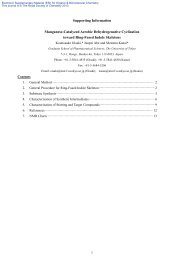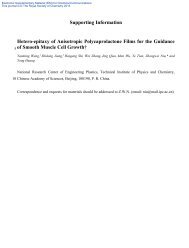Representation of Ethnic Groups in Chemistry and Physics
Representation of Ethnic Groups in Chemistry and Physics
Representation of Ethnic Groups in Chemistry and Physics
Create successful ePaper yourself
Turn your PDF publications into a flip-book with our unique Google optimized e-Paper software.
Executive summary<br />
“In particular,<br />
medic<strong>in</strong>e,<br />
dentistry,<br />
pharmacology<br />
<strong>and</strong> ophthalmics<br />
all have very high<br />
numbers <strong>of</strong><br />
Indian <strong>and</strong><br />
Pakistani<br />
students relative<br />
to their numbers<br />
<strong>in</strong> the<br />
undergraduate<br />
population as a<br />
whole.”<br />
as likely to achieve an A-level <strong>in</strong> physics as white students. However, black Caribbean students<br />
are only a sixth as likely to achieve an A-level <strong>in</strong> physics as their white counterparts.<br />
The third stage <strong>of</strong> the educational pipel<strong>in</strong>e is achievement <strong>of</strong> the qualifications to study<br />
chemistry or physics at undergraduate level. Approximately two-thirds <strong>of</strong> students achiev<strong>in</strong>g<br />
an A-level <strong>in</strong> chemistry are qualified to study chemistry at undergraduate level, based on prerequisite<br />
qualifications as outl<strong>in</strong>ed <strong>in</strong> the study; <strong>and</strong> approximately half <strong>of</strong> students achiev<strong>in</strong>g<br />
an A-level <strong>in</strong> physics are qualified to study physics at undergraduate level, based on<br />
comb<strong>in</strong>ations <strong>of</strong> subjects studied <strong>and</strong> grades achieved. Significant differences between ethnic-m<strong>in</strong>ority<br />
groups are not observed at this stage.<br />
Evidence is found <strong>of</strong> systematic differences <strong>in</strong> subject choices by ethnic group for students<br />
choos<strong>in</strong>g chemistry or physics over other subject areas at degree level, the fourth stage <strong>in</strong> the<br />
pipel<strong>in</strong>e. This is most notable <strong>in</strong> physics where all ethnic-m<strong>in</strong>ority groups, except Ch<strong>in</strong>ese students,<br />
are under-represented relative to their numbers <strong>in</strong> the undergraduate population, <strong>and</strong><br />
relative to numbers <strong>of</strong> students qualified to study chemistry or physics by their A-levels.<br />
Consequently, physics is very much white (<strong>and</strong> male) dom<strong>in</strong>ated.<br />
In chemistry there is a less clear-cut difference between ethnic groups. <strong>Ethnic</strong>-m<strong>in</strong>ority groups<br />
<strong>in</strong> general are over-represented <strong>in</strong> chemistry, relative to their numbers <strong>in</strong> the undergraduate<br />
population, with the exception <strong>of</strong> black Caribbean students. However, even <strong>in</strong> this case the<br />
numbers are over-represented based on the numbers <strong>of</strong> potential undergraduate black<br />
Caribbean chemists.<br />
Alternative areas <strong>of</strong> study<br />
This report also compares alternative areas <strong>of</strong> study. With<strong>in</strong> science, eng<strong>in</strong>eer<strong>in</strong>g <strong>and</strong> technology<br />
(SET) subjects a general bias is found among ethnic-m<strong>in</strong>ority students aga<strong>in</strong>st traditional<br />
areas <strong>of</strong> science, such as the physical sciences, the biological sciences <strong>and</strong><br />
mathematics. In contrast, ethnic-m<strong>in</strong>ority groups <strong>in</strong> general tend to be over-represented <strong>in</strong><br />
<strong>in</strong>formation, communication <strong>and</strong> technology (ICT), <strong>and</strong> computer science, compared with<br />
their white counterparts. Outside science, a very strong bias towards medic<strong>in</strong>e <strong>and</strong> related<br />
subjects is found among non-white groups, especially Asian students. This supports the earlier<br />
observation that chemistry is a popular A-level subject with ethnic-m<strong>in</strong>ority groups because<br />
it is a prerequisite for medic<strong>in</strong>e. In particular, medic<strong>in</strong>e, dentistry, pharmacology <strong>and</strong> ophthalmics<br />
all have very high numbers <strong>of</strong> Indian <strong>and</strong> Pakistani students relative to their numbers<br />
<strong>in</strong> the undergraduate population as a whole.<br />
In addition, ethnic-m<strong>in</strong>ority groups generally show a preference towards other vocational<br />
subjects, such as bus<strong>in</strong>ess <strong>and</strong> adm<strong>in</strong>istration or law. Black Caribbean students, however,<br />
are different from most ethnic-m<strong>in</strong>ority groups, show<strong>in</strong>g a general preference for arts, social sciences<br />
<strong>and</strong> humanities subjects.<br />
The fifth stage <strong>of</strong> the educational pipel<strong>in</strong>e is the achievement <strong>of</strong> a first or upper-second-class<br />
degree, which represents the normal qualify<strong>in</strong>g st<strong>and</strong>ard for further study, especially at doctoral<br />
level. There is strong evidence <strong>of</strong> significantly different patterns <strong>of</strong> achievement <strong>in</strong> chemistry<br />
<strong>and</strong> physics by ethnic group at the conclusion <strong>of</strong> undergraduate studies. White students<br />
have much higher rates <strong>of</strong> success <strong>in</strong> achiev<strong>in</strong>g a first or upper-second degree, <strong>and</strong> thus are <strong>in</strong><br />
a better position to access postgraduate chemistry, physics or related science courses. This differential<br />
achievement by ethnic group is found not only <strong>in</strong> chemistry <strong>and</strong> physics but across<br />
most subject areas. However, there is evidence that most <strong>of</strong> this differential achievement may<br />
be expla<strong>in</strong>ed by subject choice <strong>and</strong> because many ethnic groups are over-represented <strong>in</strong> the<br />
iv R EPRESENTATION OF E THNIC G ROUPS IN C HEMISTRY AND P HYSICS M AY 2006
















